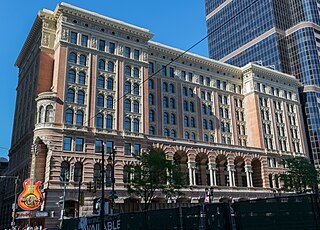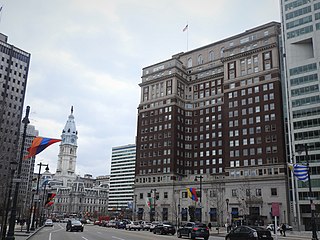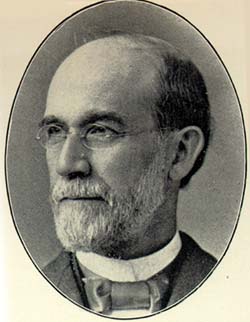
The Philadelphia Naval Asylum is a complex of buildings at Gray's Ferry Avenue in Philadelphia, Pennsylvania. Built in 1827 as a hospital, it later housed the Philadelphia Naval School, served as a home for retired sailors for the United States Navy from 1834 to 1976, and was ultimately redeveloped as luxury condominiums. The site was placed on the National Register of Historic Places and designated a National Historic Landmark in 1971, primarily for its architecture.

Brewerytown is a neighborhood in the North Philadelphia section of Philadelphia, Pennsylvania. An unofficial region, Brewerytown runs approximately between the Schuylkill River's eastern bank and 25th Street, bounded by Montgomery Avenue to the north and Parrish Street to the south. Brewerytown got its name because of the numerous breweries that were located along the Schuylkill during the late 19th century and early 20th century. It is now primarily a residential neighborhood, with a growing and active commercial sector along Girard Avenue.

Beth Sholom Congregation is a Conservative synagogue located at 8231 Old York Road in the Philadelphia suburb of Elkins Park, Pennsylvania. It is the only synagogue designed by famed architect Frank Lloyd Wright. Beth Sholom is Hebrew for House of Peace. Completed in 1959, it has been called a "startling, translucent, modernist evocation of an ancient temple, transposed to a Philadelphia suburb by Frank Lloyd Wright. It was designated a National Historic Landmark in 2007 for its architecture.

The Reading Terminal is a complex of buildings that includes the former Reading Company main station located in the Market East section of Center City in Philadelphia, Pennsylvania, United States. It comprises the Reading Terminal Headhouse, Trainshed, and Market.

Gravers station is a SEPTA Regional Rail station, which is located at 300 East Gravers Lane at Anderson Street, Philadelphia, Pennsylvania. The station building is listed on the Philadelphia Register of Historic Places and the National Register.

Knowlton Mansion, also known as the Rhawn Residence, is an historic mansion that is located in the Fox Chase neighborhood of Philadelphia, Pennsylvania, United States.

Hope Lodge is a historic building located at 553 South Bethlehem Pike in Fort Washington, Pennsylvania, in the United States. This mansion has been described as "one of the finest examples of Georgian Colonial architecture in this part of the country. It was used by Continental troops during the 1777 Philadelphia Campaign during the American Revolution.

Carpenters' Hall is the official birthplace of the Commonwealth of Pennsylvania and a key meeting place in the early history of the United States. Carpenters' Hall is located in Independence National Historical Park in Philadelphia, Pennsylvania.
The Philadelphia Register of Historic Places (PRHP) is a register of historic places by the Philadelphia Historical Commission. Buildings, structures, sites, objects, interiors and districts can be added to the list.

The Arch Street Meeting House, at 320 Arch Street at the corner of 4th Street in the Old City neighborhood of Philadelphia, Pennsylvania, is a Meeting House of the Religious Society of Friends (Quakers). Built to reflect Friends’ testimonies of simplicity and equality, this building is little changed after more than two centuries of continuous use.

The Insurance Company of North America Building is a historic commercial building in downtown Philadelphia, Pennsylvania, United States. Built in 1925, it was for many years the home of the Insurance Company of North America (INA), the nation's first and oldest joint-stock insurance company. It was designated a National Historic Landmark in 1978. The building, occupied by INA until 1991, has been developed into condominiums.

The Carl Mackley Houses, also originally known as Juniata Park Housing, is a private apartment complex in the Juniata neighborhood of Philadelphia, Pennsylvania. Built in 1933–1934 as single-family apartments, it opened in 1935. The project was sponsored by the American Federation of Full-Fashioned Hosiery Workers, with financing by the Housing Division of the Public Works Administration, of which it was the first funded project. The complex was named for a striking hosiery worker killed by non-union workers during the H.C. Aberle Company strike in 1930.

The Edwin Forrest House is an historic house and arts building, which is located at 1346 North Broad Street in Philadelphia, Pennsylvania. Built between 1853 and 1854, it was home, from 1880 until 1960, to the Philadelphia School of Design for Women, at one time one of the nation's largest art schools for women.

Addison Hutton (1834–1916) was a Philadelphia architect who designed prominent residences in Philadelphia and its suburbs, plus courthouses, hospitals, and libraries, including the Ridgway Library and the Historical Society of Pennsylvania. He made major additions to the campuses of Westtown School, George School, Swarthmore College, Bryn Mawr College, Haverford College, and Lehigh University.

John Torrey Windrim was an American architect. His long time chief designer was W. R. Morton Keast.

The Masonic Temple is a historic Masonic building in Philadelphia. Located at 1 North Broad Street, directly across from Philadelphia City Hall, it serves as the headquarters of the Grand Lodge of Pennsylvania, Free and Accepted Masons. The Temple features the Masonic Library and Museum of Pennsylvania, and receives thousands of visitors every year to view the ornate structure, which includes seven lodge rooms, where today a number of Philadelphia lodges and the Grand Lodge conduct their meetings.

John A. Dempwolf (1848–1926) was a German-born American architect practicing in York, Pennsylvania from 1876 until his death in 1926. In association with his brother Reinhardt Dempwolf and son Frederick G. Dempwolf, he was responsible for the design of some five hundred buildings in and around Pennsylvania.

Alden Villa, also known as Millwood, is a historic home located in Cornwall, Lebanon County, Pennsylvania. Representative of the Queen Anne and Shingle Style, it was designed by Stanford White, one of the leading architects of the Gilded Age. Built in 1881, the home and its eight-acre property were added to the National Register of Historic Places in 2011.

Germantown Grammar School, also known as Lafayette Grammar School and Opportunities Industrial Center, Inc., are two historic school buildings located in the Germantown neighborhood of Philadelphia, Pennsylvania.

The Marian Anderson House is a historic home located in the Southwest Center City neighborhood of Philadelphia, Pennsylvania. Built circa 1870 in the same neighborhood where opera singer and civil rights advocate Marian Anderson was born 27 years later, this two-story, brick rowhouse dwelling was designed in the Italianate style. Purchased by Anderson in 1924, the same year she became the first African-American concert artist to record spirituals for a major American recording company, she continued to reside here until 1943. The house is currently home to the Marian Anderson Museum and Historical Society.
























